Archive for the 'exterior projects' Category

Spruce up your home with some curb appeal
By Relocation.com
Your front yard is one of the first things a homebuyer will notice. You may have brand new kitchen appliances, or have excellent hardwood floorings, but if you don’t have curb appeal, buyers may not be interested in checking out the interiors of your home. One of the best ways to reel in potential buyers is to curb appeal. Here are 10 ideas to make your curb look attractive.
1.) The exterior home: Before starting on your yard, check the physical appearance of your house. Take a look at the entire neighborhood and get a general idea about colors. Try and choose colors that stand out among other houses but are not very loud. Pressure washing bricks and curbs is also an excellent idea.
2.) Highlight your home: Make sure to accentuate the features of your home. If you have a drive way you could install lights or have decorative pillars that lead a way to your home. Having beautiful plants and shrubs will also add in curb appeal.
3.) Interior decorations shouldn’t hamper the exterior appeal: Several homeowners decorate their home such that they hamper the exterior beauty of the house. Your interior furniture and fittings should not be seen if you are standing on your curb. Your curb should be an extension of your interiors but it should have its own identity as well.
4.) Entry areas and walkway: Your entry areas and walkways are one of the most important factors of your home. You can improve the look of your sidewalk, driveway, and stairs around your house by removing all debris, weeds, and washing your pavement. If you park cars on your driveway, make sure you clean all oil and petrol stains.
5.) Keep unsightly items away: Curb appeal is associated with the way your family lives. Garbage cans, debris, trash bags, and gardening tools must be kept away from your curbs. These items will give your house an unkempt look, and help homebuyers form negative opinions about your home.
6.) Manicured gardens: Make sure your grass is cut and trimmed at regular intervals. If you have flower beds or shrubs, they must be watered and cared for. For dead and dry spots on your garden, you can buy garden fixtures and hide them.
7.) Constant care is essential: Caring for your home must be a part of your daily routine. If you start caring for your house because buyers are coming, the effects may not have the same impact as maintaining it.
8.) Replace old items: Things like mailboxes, number plates and hardware that are installed in around your house have a major impression on the buyers. Buy new elements to replace the older ones.
9.) Spice up your outdoor furnishings: The appearance of your outdoor and patio furniture should be fresh and clean. These are considered leisure areas and should always appeal homebuyers.
10.) Add exciting colors: To get curb appeal, you must consider adding some color to your yard. Getting in colorful flowering plants and furniture will add additional color to the exterior section of your home.
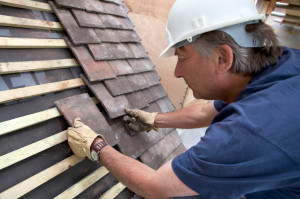
Know what to look for when seeking to hire a contractor.
By Dermound Becker
Special to Relocation.com
When it comes to hiring a contractor to do work in your home, you need to take your time in choosing just the right one for you. A contractor is going to have people spending time in your home, so they need to be trustworthy and professional. Here are some helpful tips for choosing the right contractor for you.
• Get as many bids/quotes as you can. Not only are you looking for a good price, but the more quotes you get, the better idea you have as to what the going rate in your area is for the work you want done. Remember, though, that the cheapest quote may not prove to be the best contractor for the job. Ask if the quote is a hard quote (the actual price that you will be charged) or just an estimate.
• Ask for references and then, actually call the people. Find out if the job was completed entirely to the customer’s satisfaction. Was the work completed on time? Was the work site kept clean and safe? How close was the final bill to the estimate that was provided? And would they consider hiring this company again.
• Is the contractor fully insured, licensed and bonded? Are ALL of his employees insured as well? The employees should be covered by workman’s comp and liability insurance. Also ask if the contractor is a member of any trade associations.
• Check online for litigation history for the company. If they have been sued a number of times, this would be a definite red flag. You should also call the Better Business Bureau. They can provide you with a lot of useful information as to the company and its business history in the area.
• Find out how long the contractor has been in business. As a general rule of thumb, a contractor that has been in business for at least five years is probably reliable. It is difficult to stay in business that long if they are doing shoddy work.
• Ask if the price covers everything, such as permits, materials or blueprints . You should know the actual cost before you start working with a contractor.
• Make sure you choose a contractor that you are comfortable communicating with. Does he or she really listen to you? Are they taking what you want done seriously? After all, this is your job, your home and you should have the final say in decisions. The contractor should have ideas to present to you, but you make the final decision.
• Is the contractor going to be easy for you to reach if you need to? They should respond to your messages the same day.
You should realize that problems can arise. Weather, material problems, any number of reasonable problems can pop up and slow the course of your home improvement project. The contractor should communicate fully with you about these. But make sure that it clearly states in the contract before you sign it what will happen if there is a dispute. Mediation is a lot less costly than having to go to court.
Choose wisely and your home improvement project should go through without a hitch.
Don’t forget to like us on Facebook and follow us on Twitter!
• Follow us on Twitter @Relocation_News
• Become a fan of Relocation.com on Facebook

Follow our simple tips when learning how to compost.
By Maria Paulia Belgado
Special to Relocation.com
Whether you own a country cottage that has large gardens or a posh city apartment with a few flowerpots, you should consider composting to benefit both your garden and the environment. Composting is essential, as it keeps waste products away, and fertilizes the land without any chemicals. It works by degrading plant substances into humus, which is very rich kind of fertilizer. In simple terms, composting means recycling plant products to create something useful.
There are several ways of creating compost. These include heaping up leaves and hay and allowing the pile to decompose. However, if you wish to decompose kitchen waste, try mixing dry and wet scraps in a silo and allow it to be aerated. This will create heat and help with the decomposition. This process can be used by apartment dwellers. However vermin composts are best for people living in flats. In vermin composts, essential bacteria decompose kitchen scraps into smaller particles and create food for the worms. In turn the worms excrete moist, odorless and rich compost.
There are several kinds of worms found for this purpose, but most use the red wigglers. These can be purchased online, or from bait shops and garden centers. After you have bought the worms, cut a newspaper into thin strips and place it at the bottom of a container, and moisten it with some water until it’s damp. Then, place the worms and the mud that came along with those. Cover the container and place it in a cool and dark place, making sure the temperature is not too hot or too cold.
Now is the time to feed those worms. Put in kitchen scraps and cover with mud in one corner. After a few days, add more scraps in another corner. Rotate these corners every time. The first will be ready by the time you reach the last one. Whenever you add wastes, make sure you bury in rotation. Few months later, there will be less paper and lots of crumbly, brown stuff in the container. The compost is ready. Once the compost is ready, you can easily scoop it up and use it. To create a new set of compost, clear all the materials of the container and repeat the entire process again.
If you want to have good quality compost you should also avoid garlic, spicy and salty stuff, which are poisonous for worms. These worms will reproduce while they are decomposing your scraps. In case of overcrowding you can donate those worms to schools, bait houses or to a plant nursery.
All of these methods mentioned above are really low-maintenance and easy for you. The best thing about composting is that it is free, fabulous and extremely useful for your plants. The humus you create from your own wastes and scraps will help your plants stay healthy and thrive well.
Don’t forget to like us on Facebook and follow us on Twitter!
• Follow us on Twitter @Relocation_News
• Become a fan of Relocation.com on Facebook
March 21st, 2011 by
Admin
Categories:
design and decorate,
Do It Yourself,
exterior projects,
Home Improvement,
interior projects,
Moving,
Moving Day,
Moving Industry,
self storage,
Storage,
storage facilities,
storage units Comments:
No Comments » 
Arm yourself with an arsenal of cleaning products to tackle spring cleaning!
By Serena Norr
It’s officially spring! Even though it’s still pretty cold out there, we are getting excited about shedding our bulky winter coats, getting a much-needed dose of Vitamin D and cleaning out our homes for the season. Spring cleaning is a great way to get rid of items that you no longer need by donating, tossing them or placing them in storage – making your home more functional and organized. Here are some simple tips to make your house a lean mean clean machine this spring.
1. Start with the windows. An often neglected part of any house, the windows are also the easiest places for dirt and grim to acclimate. Using a rubber-edge squeegee or a sponge, mix a bucket with water and some window cleaner. Wipe and repeat until the windows are spic and span. You may also need to use a dry cloth afterward to ensure that you removed all of the dirt. While your doing this make sure you also wash your window blinds and/or curtains.
2. Change your linens. Do you have frayed and broken down linens? Spring is a great time to try new patterns and update your home with lighter and brighter colors (think feel good colors for summer!) We love flowing duvets with pale greens, yellows and lavenders.
3. Clean the refrigerator. Your fridge should really be cleaned all the time, but the winter has a way to make it easier to acclimate containers of old food – leading to mildew and pretty nasty smells. Even if you do throw out old boxes of Chinese food before it goes bad, you (most likely) aren’t rigorous about cleaning out your entire fridge. Start by taking everything out (yes, we mean everything) and throw out anything that is old or has a strange smell and/or resembles something of a science project (e.g. mold). Remove the drawers and shelves from the fridge and wash off any dirt, crust or old food. You can also scrub difficult-to-get areas with a scrub brush and/or an old toothbrush. Throughout the spring and summer get in a habit of regularly cleaning your fridge and freezer by making it a part of your normal cleaning schedule (about twice a month).
4. Clean those rugs. Rugs and carpets can very easily acclimate dirt and dust (even if you regularly vacuum). In the spring, deep clean your rugs or carpets by using a strong cleaner or hiring a professional cleaning company. Since these solvents are pretty strong, be sure to keep the windows open and try to avoid staying where the carpets are for a few hours. If you don’t have rugs, make sure to sweep, scrub and mop your floors.
5. Go through your closet. Ah, the closet, the quintessential dumping ground for all seasons. Use the spring as a way to de-clutter your closet and make some sense of the mess. Start by removing any winter items – like bulky coats and sweaters – and place them into boxes for storage or storage bins to be placed under your bed or in your garage. If there are items that you don’t need (or really never use), consider this a time to get rid of them once and for all by donating them to a local charity or give them to friends and family members. Since it is getting warmer, you may also want to sell them at a garage sale. It’s up to you how you get rid of them but the main thing is that you actually get rid of them. This also applies to shoes, bags, belts and the random knick knacks that often have a way of getting tossed into closets.
6. Junk draws no more. Junk draws are called junk drawers quite simply because they are a nesting ground for all the random things in our homes. Instead of making it all about junk, make these drawers practical and useful. Start by taking everything out of your drawer in order to clean it. Look through the contents and decide – what you really need and what is just garbage. Is your drawer filled with random nails or old tape? If you don’t need it, you may want to toss it. Oftentimes these useless items just live in our drawers until moving day. You may also consider purchasing a storage unit for your drawers in order to keep your items organized and neat.
7. Don’t forget these drawers. Cleaning not only applies to your junk drawer but should apply to your medicine cabinets, silverware drawers, cupboards and clothing drawers. Get rid of any expired medications, clean your silverware and go through your cupboards for old food. You should also go through your clothing drawers – they same way you did through your closets – and get rid of anything you no longer need or use.
8. Update your look. Just like update your style, you should also do the same for the look of your house. Your home is a place to seek refuge and find comfort and you can’t find such peace in a home with dreary colors or one that has dirty walls. Start by washing and scrubbing the walls. Then decide on a new paint scheme. Before you paint the entire home, be sure you know your vision and what “look” you want for your new home. You can purchase samples of a color or bring home color swatches before you make your final decision. Also, look through magazines and cut out pictures that resemble the look you want. After you paint, consider hanging up artwork and/or family pictures to give your home a personal touch.
Spring cleaning isn’t easy and sometimes can’t be fun, but it is a great way to shed some excessive junk from your home as you lighten up for the summer. You will not only feel better about losing these unnecessary layers of junk, your home will look brighter and become more functional – making it truly a place to find comfort.
Other areas to clean:
- Attic, garage or any other home storage units
- Home office
- Light fixtures
- Outdoor area
- Kid’s rooms
Don’t forget to like us on Facebook and follow us on Twitter!
• Follow us on Twitter @Relocation_News
• Become a fan of Relocation.com on Facebook
January 26th, 2011 by
Admin
Categories:
Celebrity Real Estate,
condos,
design and decorate,
Do It Yourself,
exterior projects,
foreclosures,
Home Improvement,
homes for sale,
House Swap,
interior projects,
Mortgages,
Moving,
Moving Industry,
Packing,
Real Estate,
Relocation,
rentals Comments:
No Comments » 
Moving to the city or the country? Read our detailed list about the pros and cons of both.
Transitioning Between the City and the Suburbs?: Here’s What You Need to Know about Making the Move
By Faith Teel
Special to Relocation.com
As the old saying goes, “The grass is always greener on the other side.” Whether you’re headed out to the wide-open spaces of the suburbs or moving into the exciting neighborhoods of the big city, you might find that you’ve gotten more than you’ve bargained for. Here are just a few examples of the things they don’t tell you in the advertisements.
Moving to the Suburbs
Long Commutes and Distant Stores – Many people move to the suburbs in search of more space to raise a family or grow a garden. Unfortunately, there is a flip side to having more space: everything is farther apart. Your commute will probably be longer, and you’ll have to drive, because most suburbs are too spread out to make public transportation cost-effective. In some places, it’s common to have an hour-long commute in each direction, which may mean 10 hours that have disappeared from your week.
The lack of public transport also means that you’re more likely to encounter the greatest terror to ever stalk the streets: the teenage driver. In cities, teens can often walk or catch the bus to socialize, but some suburbs are so spread out that a jog to the local coffee shop would be a three-hour marathon. Suburban teens usually get cars long before they get good judgment about driving them.
A Cultural Vacuum – One of the first things that urbanites miss when they move to the suburbs is the variety that cities offer. Many suburbs are extremely homogenous, with cookie-cutter houses and cookie-cutter restaurants. Even the people often seem the same, because few suburbs are economically or ethnically diverse. Don’t bother to look for museums, and feel lucky if a few of the chain restaurants offer take-out or delivery.
Where Are All the People? – The very privacy that you came looking for can also be your downfall in the ‘burbs,’ because everyone around you moved out here for privacy as well. With everyone so spread out, it can take a long time to meet new people.
Crime is Everywhere – Yes, there is usually more crime in the city, but the suburbs are not exempt from it. There’s lots of petty theft in suburbs, and there are still gangs and drug use in the high schools. Your kids are less likely to get mugged, but that doesn’t mean you should leave your doors unlocked at night.
The Grating Outdoors– One of the biggest surprises for ex-urbanites is the proximity of Mother Nature in the suburbs. If you’ve never had to mow a lawn or check the kids for ticks, you’re in for quite an experience.
Moving to the City
No Space – The city is an exciting place to be and a great place to find work, which is probably why you want to be there. Unfortunately, everyone else wants to be there too, and that drives up the price of real estate. If you want to live in a reasonably safe neighborhood, be prepared to pay through the nose for a tiny apartment.
For the same reasons, city parking is often impossible. People often sell their cars when moving to the city, which means you will have to rely on public transportation such as buses and cars.
Other People – Other people are everywhere in the city, and that can take some getting used to. Traffic is often worse, but the real nuisance is the noise, smells and constant crowds.
Goodbye, Mother Nature – It can be hard to get in tune with nature in the city. The parks are often crowded with other people (see above) and some may not even be located within a close distance to your home. If you manage to score a balcony or small yard with your apartment, keep in mind that the pollution can be hard on plants and trees. It’s also tough to keep animals in the city, especially big dogs that need room to roam.
School Roulette – In the city, it’s easy to get to know other parents, and you’ll need this advantage when it comes to getting your kids into a good school. In the suburbs, getting into the right school is usually a matter of buying a house in the best neighborhood. In the city, finding the right school is a combination of luck and strategy, and every city’s rules are different. You won’t even have to raise this topic at your kids’ next playdate, because it will be the first thing on every parent’s mind.
Abrupt Changes in Neighborhoods – With everything in the city so packed together, it can be hard to tell at first glance which neighborhoods are safe and which aren’t. In some cities, the transition from slum to swank can happen in just one block. The transient nature of a community’s character becomes more obvious over time. One day, you could wake up to discover that your edgy, artistic neighborhood has become a slum or a yuppie’s paradise.
Whether you’re searching for greener grass in Levittown or the Big Apple, one thing is certain: you’re sure to need some time to adjust. Before you make the jump, take a little bit of extra time to explore the community that you’re moving to. No two cities are alike, and the same is true for suburbs, so if you don’t like what you see, look elsewhere. The quality of your life depends on it.

A few small changes can really enhance your home - Image Credit: http://www.outinhome.com/
By Faith Teel
Special to Relocation.com
The second day of January often brings a sense of relief: you’ve gotten all of your vacationing out of your system, and now you’re ready to roll up your sleeves and dive back into your daily life.
The first weeks of a new year are also a great time to spruce up your house. After all, you’re already taking down the Christmas decorations, so you might as well redecorate a little bit while you’re at it. Here are a few suggestions to get you started.
Get crafty. Are you snowed in with nothing to do? Why not get out those crafty projects you’ve been meaning to tackle? This is a great time of year to repaint an old lamp, make a collage for your bedroom wall or sew a new pair of curtains. Start the year with a little bit of artistic inspiration, and set a trend for the rest of the year.
Bring the outdoors in. Sometimes winter can make a house feel drab and glum. If you’re really longing for spring, stop by your local nursery or florist and pick up a few forced bulbs. You can also perk up your home by taking a cue from the Japanese, who change the artwork on their walls in response to the seasons around them. This winter, why not pick up an inexpensive poster that reminds you of warmth and sunshine?
Do a thorough housecleaning. A chilly day is ideal for cleaning your home from top-to-bottom, because household chores give you a little exercise without actually forcing you to go outside. Now is the time to dust the chandelier, clean the lint out of the laundry room, shake the breadcrumbs out of the toaster and re-fold all of the sheets in the linen closet.
Update your light bulbs. Especially if you have high ceilings that put your light fixtures out of reach, it’s easy to put off changing your light bulbs. You need all of the bright light that you can get in winter, so make sure that all of the bulbs in your house are working. While you’re at it, dust off any glass shades, and give the fabric ones a good scrub in the sink (or at least spot-clean them).
Get ready for spring. Speaking of warmth and sunshine, winter won’t last forever. Now is the time to plan next year’s garden. Even a small apartment balcony has room for a few planters. Use them as an excuse to page through gardening catalogs and dream of summer flowers.
Give to charity. This winter, take a few minutes to sort through your stack of canned goods and other dry food. Food pantries often get lots of donations before Christmas, only to fall short later in the season. Why not give those dusty tins to someone who will appreciate them?
Don’t forget your clothes closets. This is a great time of year to sort through your bedroom closets and get rid of any summer clothes that you’ll never wear again. (Hint: if you didn’t wear it last summer, you probably don’t need it.)
Patch it up. Need a little coziness on a cold afternoon? Try an old-fashioned remedy: mend your clothes and other household items. This is a great time to sit in a comfortable chair in the warmest part of the house and sew patches onto old bed sheets or fix a tear in your favorite skirt. A cup of tea and an audio book can round out the picture and turn an otherwise dull chore into a pleasant refuge from your worries.
Paint the town—or just the house. If you manage to catch a few days of winter thaw so that you can open your windows for ventilation, now is a great time to repaint your walls. Pale, warm colors are an excellent choice in winter, because they reflect more of that scarce sunlight. Even if you can’t get a warm enough day to repaint a whole room, get out your cans of touch-up paint and freshen up the spots where the kids have been leaving hand prints.
Having a home that’s bright and clean is a great way to beat the winter blues. As you while away the days until spring, get ready for the new year by cleaning house and freshening up your surroundings. It will keep you feeling energized and uplifted all season long.
Don’t forget to like us on Facebook and follow us on Twitter!
• Follow us on Twitter @Relocation_News
• Become a fan of Relocation.com on Facebook
December 31st, 2010 by
Admin
Categories:
design and decorate,
Do It Yourself,
exterior projects,
Holidays,
Home Improvement,
interior projects,
Moving,
Moving Day,
Moving Industry,
Storage Comments:
No Comments » 
Happy 2011! (Image Credit: AL.com)
By Serena Norr
It’s that time of year again; out with the old and in with the new. Part of that old might involve upgrading your home with a renovation or new design or throwing out your old clothes or moving to a new town or city – all exciting prospects that warrant a few pointers in the new year. As we say goodbye to 2010, we wish you the best of luck with your prospective change and have a few pointers to help you make your 2011 brighter, more exciting and more organized! Happy New Year from all of us at Relocation.com!
1. Moving in the New Year? Whether you are planning a big move across the country or a small move around the block, we advise planning ahead. All too often we hear stories of people scrambling for movers – only to use the first company that they find. We always advise researching three to five licensed moving companies from a reputable resource such as Relocation.com AND to have the movers come to your home for an in-house moving estimate. Taking estimates over the phone is a huge NO for 2011 – these prices are not binding and are subject to increase on moving day. Having movers come to your home allows them to see your belongings (thus determine the price) and this is also a great opportunity to ‘interview’ them – where you can ask them about anything from their insurance policy to how long they have been in the industry. No questions are off limits.
2. Decorating? Designing? Renovating? If you staying put you may want to spruce up your home with an exciting decorating project or an entire home renovation. No small feat, you should start by determine if the project is a necessity (leaky faucets) or a want (painting a room). The necessity should take precedence over the want and in some instances should only be handled by a professional. Be honest with yourself by what you can handle. You don’t want to start a huge project only to find out that you made a bigger mess that you started out with. As with finding a mover, meet with three to five contractors, architects or home improvement experts to discuss your project. They can also tell you how long they are expected to work in your home, what fees are involved and what the room will look after the project (if you designing). If it is a simple project, like painting, create a plan for yourself. Make a note of your budget, prospective color scheme and the estimated time line. Visit your local hardware store and bring home a few samples before you begin the job – also make sure to ask about what supplies you will need.
3. Out with the old in with the new. The New Year is a great time to get rid of some junk that you have been hoarding. Oftentimes we hold on to items that we no longer need or no longer realize that we even have. This turns into junk; leaving our homes filled with tons of useless stuff. Of course, some items are valuable or sentimental to us but still may not have a place in our homes. In those instances, consider keeping your belongings in a secure and climate-controlled storage facility. Going from room-to-room, evaluate your stuff by placing your items in a keep, toss or donate/store pile. Be honest with yourself about your needs vs. wants as well as your space restrictions. Items in the keep pile are necessities. Items in the toss and donate pile can be sold in a garage sale or donated to a local charity or to the Salvation Army.
4. Storage solutions. We are huge fans of storage – as mentioned above. This doesn’t only include housing your belongings in a self storage facility but placing your items in smaller organizational units to clear up some space. We love under-the-bed storage options such as this one from Bed Bath and Beyond and this modular closet system that organizes items in your closet. The kitchen and the bathroom are also major areas for clutter. Consider using roll-out under-cabinet drawers to contain and organize anything from products to dish towels.
Stick with your housing or moving resolution for 2011 – big or small – Relocation.com is here to help you every step of the way!
More Ideas for the New Year:
Don’t forget to like us on Facebook and follow us on Twitter!
• Follow us on Twitter @Relocation_News
• Become a fan of Relocation.com on Facebook
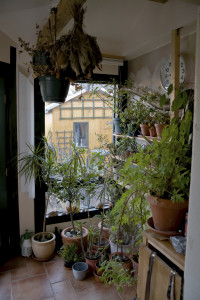
A few indoor plants can really brighten up your home
By Vance Stevens
Special to Relocation.com
While commercial settings typically offer an atmosphere of large, indoor plants, they don’t have to be limited to dentists’ offices and malls. In fact, indoor plants add beauty and function to any indoor space and can be a perfect addition to brighten up your home during those chilly winter months. Green plants also help filter the air, creating a healthier environment for work or play. And with a few strategically placed indoor plants, you can transform an ordinary space into a stress-free zone. Here are a few indoor plants that will help you brighten up your favorite room.
Palm – Coming in a wide variety of sizes and leaf shapes, palms range from just a few feet to over 20-feet tall. A few of the most popular pines are the Sentry and Bamboo palms, which can reach an average height of 9 to 10 feet, and the Areca and Chinese Fan palms, which average 5 to 6 feet in height. There are many different type palms to will meet your style needs.
Chinese Evergreen – The Chinese evergreen is an excellent selection for indoor gardening and decoration. With its low lighting needs and low maintenance, the plant is an aesthetic addition as well as a healthy one that is listed as a natural indoor air purifier.
Norfolk Island Pine – If you are looking to add a touch of the tropics indoors, Norfolk Island pines can reach a height of more than 10-feet and bring with them a rich aroma of the great outdoors. The plant’s resemblance to another type pine has made it a popular holiday decoration. Norfolks can survive in only household incandescent or fluorescent lighting if they receive a minimum of 16 hours of light each day.
Chrysanthemums – Chrysanthemums are resilient, colorful flowers that are grown indoors in any climate and outdoors. The plant is easy to care for and thrives with given exposure to at least a half-day of sunlight, moist soil and room to breathe. Chrysanthemums come in a wide variety of shapes and colors.
Ficus – There are several types of Ficus (also known as figs), and a large majority of them come well-suited for the role of large, indoor plant. Ficus Alii, (a type of Ficus characterized by deep green, long, narrow leaves) rubber plants and fiddle leaf figs are some of the most popular, and grow from 4 to 12 feet tall. The Ficus requires daily sunlight, ample humidity and water every 1-2 days.
Spider Plant – Spider plants are fast-growing, attractive perennials that feature slim, elegant leaves and small white flowers. A plant able to tolerate low-light conditions well, the spider plants can grow in the shade if given continually moist soil. If left in extended dry conditions, the tips of the long leaves will turn brown until water resumes. The spider plant is also excellent for filtering airborne toxins.
Wandering Jew – The wandering jew is a popular indoor plant that good for cleaning the air in the room. It is often grown in a hanging basket due to its sprawling tendencies. The plant’s 3-inch-long leaves are charmingly spotted and covered with a fine layer of soft fuzz. Place the plant in rich, loose soil in a dimly lit spot; remember to keep the soil moist for optimal growth.
Succulent/Cactus – There are several types of succulents and cacti that make impressive large, indoor plants. Milk Stripe euphorbia often exceed four feet in height and are nearly as wide. There are a number of tall, upright cactuses perfect for the indoors, such as Snowball, Silver Torch and the Column cactus.
If you have any questions, comments or inquires, please contact me at editorial@relocation.com.
By Serena Norr
It’s a spooky edition of The Celebrity Beat. These famous haunted houses will thrill and shock you with their ghastly tales. Don’t be too scared, after all these are just homes, right?
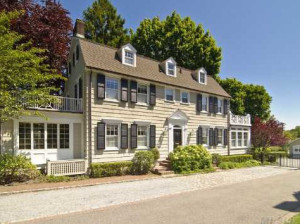
The Amityville House - (Photo Credit: Zillow.com)
1. The Amityville Horror House
Location: 108 Ocean Avenue, Amityville, New York
This haunted abode inspired by a book of the same name and five movies is often considered one of the scariest houses in America. Though we can’t say if it is haunted or not, the home located in Amityville, New York, was the scene of the horrific murder where Ronald DeFeo Jr. shot his parents and four siblings in 1974. Later sold to the Lutz family in 1975 who left after only living in the house for 28 days citing that they saw “slime oozing down walls, furniture moving, swarms of flies in the dead of winter and slamming doors,” as stated on Zillow.com. It was recently sold again (after only being on the market for 70 days!) for $1.15 million to a retired couple who states that the scariest thing about the house is the onlookers that visit it.

The Haunting in Connecticut House - (Photo Credit: AP Photo/Jessica Hill)
2. The Haunting in Connecticut House
Location: 208 Meriden Ave, Southington, Connecticut
Dubbed the Amityville of Connecticut, this former funeral parlor, located in Southington, was converted into multiple family apartments in the 1980s. In 1986, a New York family called the Snedeker’s moved into the house and began seeing demons — “one with high cheekbones, long black hair and pitch black eyes and another that wore a pinstriped tuxedo whose feet were constantly in motion,” according to the Daily Beast. The family also reportedly noticed foul smells, heard unexplained noises and personality changes in their eldest son, Philip, who started dressing and talking differently. The Snedeker’s later recruited Ed and Lorraine Warren (also involved in researching the Amityville). They reportedly had an exorcism that cleared the home of its ghosts in 1988. This story was later adapted into a movie in 2009 called The Haunting in Connecticut.
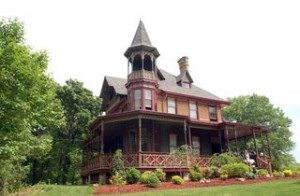
The Kresiher Mansion - (Photo Credit: http://prodigalborough.com)
3. The Kreischer Mansion
Location: 4500 Arthur Kill Road, Staten Island, New York
A prolific brick-supplier in the 1800s, the Kreischer family built two Victorian-style homes in Staten Island for the family- one home for the parents and the second, located on a secluded hilltop, was for their son. Shortly after the second home was built, the son, Edward Kreischer, shot himself and the house later mysteriously buried down. It is believed that the home is haunted by the son and his wife where guests have heard noises and doors banging. In 1996, the home was converted into a restaurant where guests and workers heard noises and doors slamming.
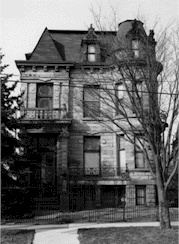
The Franklin Castle - (Photo Credit: www.prairieghosts.com)
4. The Franklin Castle
Location: 4308 Franklin Boulevard, Cleveland, Ohio
Considered the most haunted house in Ohio, the Franklin Castle, the home was built in 1865 by Hannes Tiedemann for his family. Over three years in the house, three of Tiedemann’s children died as well as well as his mother. Since his wife, Luise, was haunted by the family tragedies Tiedemann decided to expand the home to take her mind of the strange deaths. The additions included secret passageways, secret rooms, and hidden doors. Following Tiedemann’s death in 1908, it was reported that these secret rooms were not only a clever construction project. Here, he reportedly killed his niece by hanging her and is believed to have murdered a young servant girl. Additionally, a future homeowner found dozens of human baby skeletons in some of the secret rooms. Those that have lived or stayed in the home reported that they have heard strange sounds in the home like a women chocking, babies crying, organ music and footsteps. Currently, the home is dormant but it is reportedly being converted into a tourist attraction.

The mysterious Bell Witch Cabin - (Photo Credit: www.bellwitch.org)
5. Bell Witch House
Location: Adams, Tennessee
It is reported that the Bell family resided in this home in the early 1800s and started to hear strange noises. The youngest daughter, Betsy, also began to feel a gnawing like an invisible rat and the parents said they started having their blankets pulled over their heads. The Bell children also woke up with bruises on their face when the father decided to seek help. The community soon learned about the haunting and wanted to talk to the “witch” where it was reported that something from the house spoke in a husky whisper who said she was Kate Batts. As the years went on the Bell family continued to live at the house – where the witch apparently continuously beat and caused havoc to the Bell’s. Charles Bell, one of the brothers, even wrote a record of the haunting called in 1935 The Bell Witch: A Mysterious Spirit, or Our Family Troubles.
If you have any questions, comments or inquires, please contact me at editorial@relocation.com.

Showcase your pumpkin carving and decorating skills this Halloween.
By Faith Teel
Special to Relocation.com
Halloween isn’t just a time for people to dress up… houses like costumes, too! This year, why not try a few spooky decorating ideas that will scare your friends and flex your crafty muscles, without putting too many holes in your pocketbook.
Pumpkin Alternatives
Carved pumpkins are the classic Halloween decoration, but who has the time and really, who wants to clean up that mess? Luckily, there are lots of easy alternatives that won’t require you to threaten an innocent pumpkin with a huge, serial-killer-style knife.
Painted Pumpkins – All you need is a little bit of black paint to make silly or spooky faces… or get a can of glittery spray paint and paint the whole pumpkin to make the ultimate statement in Halloween glam. This is great for small kids, too, who can use as much paint or as little as possible and go wild with their Halloween pumpkin.
Squash – Next time you’re in the supermarket, look for a few pumpkin alternatives. Painted butternut squashes make fantastic ghosts and goblins… and if you keep them in a cool, dry place, they could last until it’s time to make squash casserole for Thanksgiving.
Lumpkins – Many supermarkets offer pumpkins and squashes that are so strange that they don’t need carving. Look for “peanut pumpkins,” which are covered in funny “warts” resembling peanut hulls.
Balloons – Your local card store, gift shop or florist probably sells helium balloons. Skip the pricey, shiny Mylar balloons and opt for inexpensive orange, white or green rubber balloons instead. Take them home and draw faces on them: jack-o-lantern faces for the orange ones, mummies or ghosts for the white ones and witches for the green ones.
Scarecrows – Creating a crafty scarecrow is a great way to showcase your decor skills, while also enhancing your front lawn.
Subtle Scares
One of the best kinds of Halloween decorations are the subtle ones that take a minute to notice, but really creep your friends out when they finally see them.
Things Under Glass – Save your old spaghetti jars, wash them out and remove the labels. Now fill them with mysterious-looking things and add a stick-on label with a scary name on it. For example, you could put an old rubber mask in a large jar and label it “Granny’s Pickled Heads.” Or try spiny chestnuts labeled “Poison Urchins” or dried leaves labeled “Deadly Nightshade.”
Are You Going to Eat That? – Try the same trick with jars still full of food. Tomato pesto, black olives and pickled garlic take on new meanings when labeled “Frog Hearts,” “Eye of Newt” and “Werewolf Teeth.”
Apple Crones – Peel a few apples and carve them to look like an old woman, with slits for eyes, a big nose, and a straight line for a mouth. Let the apples wither for a few days, and soon you’ll have a row of little witch faces.
Weird Family Photos – Scour the internet for old film stills of Dracula, the Mummy or Frankenstein. (Try to get high-resolution pictures.) Print them out in black and white and slip them in with other family photos. You can even make a game out of this where the first person to notice will receive a Halloween treat.
Mysterious Bloodstains – Fake blood aren’t just for costumes anymore. Squirt it on old pillowcase and then pull the pillowcase over a throw pillow. Put it on your couch for a scary touch. Just be sure to use fabric that you don’t mind putting a few stains onto!
Graveyard Trees – Now that your container garden is dying back, why not pull out a few dead annual plants and replace them with bare branches stuck into the soil like trees? You can use them as-is or drape them with cobwebs and plastic spiders.
Big Statements
Subtle can be fun, but if you’re hosting a party, you’ll want to make big changes that affect the whole atmosphere of your home. Here are a few ways to make the whole room look delightfully spooky.
Orange or Red Christmas Lights – Now is a good time to raid your bucket of Christmas lights. Orange, red or white lights all make great lighting for haunted Halloween homes.
Paint It Black – Need to make a major statement? Raid your attic, closet, garage or local yard sale for anything that you can spray paint black. Old chandeliers are great for this, and so are candlesticks and artificial flowers.
Black Bed Sheets – Are you planning to buy more bed linens soon? Why not get black or red bed sheets? They can double as quick covers for chairs and small sofas whose floral prints or bright colors might otherwise distract from your scary décor.
Cheesecloth, Cheesecloth, Cheesecloth – Cheesecloth is another inexpensive alternative for covering large furniture. It has a white, ghostlike color and an open weave that makes it look like a shroud. It’s also good for covering a Halloween table, wrapping over a mop head for an improvised ghost, or bandaging over an old hat form to make a mummy head.
Silhouettes – Black paper is your friend! Your local craft store may offer it in sheets or even big rolls. Use it to make silhouettes of mice, bats and cats, or cut larger shapes such as witches, werewolves, vampires or ghouls. Don’t limit yourself to the wall; try putting them in your baseboards, climbing up your steps or peering out of the windows.
In the Bathroom – Why not write something scary on the mirror in red lipstick, or use your spooky silhouettes or fake blood to make a great effect behind a translucent shower curtain?
Invitations – For inexpensive (yet scary) invitations, pick up some parchment paper from the same craft store and use a scary font to make your invite. (Or try a handwriting font and make your invitations look like a letter from Dracula!) Seal them up with the stick-on red wax seals used for wedding invitations.
Food Centerpieces – Halloween food is another subject entirely, but we couldn’t resist mentioning a few of our favorites. For a great centerpiece on the food table, try a mysterious green punch labeled “Love Potion.” If you’ve got a little time on your hands, adapt the classic gingerbread house with black frosting, licorice, candy corn, pumpkin candies and gummy worms to make a “haunted house.”
There’s no holiday like Halloween to bring out your inner decorator. Give a few of these tips a try… you’re sure to have a screaming good time!
August 25th, 2010 by
Admin
Categories:
Celebrity Real Estate,
design and decorate,
Do It Yourself,
exterior projects,
foreclosures,
Home Improvement,
homes for sale,
interior projects,
Mortgages,
Moving,
Real Estate,
Relocation,
rentals Comments:
2 Comments »

Tyler Perry's new home - purchased for $7.6 million. (Photo Credit: Zillow.com)
By Serena Norr
The biggest home sale this week on the Beat – in both price and size – was the massive mansion purchased by Tyler Perry aka the man behind the sassy Madea. The mansion, called Dean Gardens, was created in the early 90s by software developer Larry Dean and his wife, Lynda, who certainly had their wild imagination come to life in this overly done 58-acre mansion. From a carousel-themed nursery to art deco-inspired bedrooms, the Deans personal taste is not for everyone, and some may even say that the home is more famous for the time it has been on the market. Listed on the market since 1993 (following the couples split), Perry plans to remodel and tear several rooms in order to create an environmentally-friendly home made out of concrete. To shift from extreme homes to an aesthetically pleasing one, Bradley Whitford and Jane Kaczmarek have placed their 6,769-square-foot Italian-inspired villa on the market. The couple, who also separated, is seeking $6.7 million for their six bath, six-bedroom home. Courtney Love’s public real estate plight has been reported on Curbed NY, the New York Post, and even here on Relocation.com. Searching for a home next to Anna Wintour proved unsuccessful (Love was rejected by the condo board) and we guess living in Soho’s posh Mercer Hotel had its days numbered as Love is now leasing Milla Jovovich’s townhouse (which has been on the market since 2008). We’re interested to see how that living arrangement plays out…From extreme homes to peaceful abodes, we have you covered on the Celebrity Beat.

Front door entryway at Tyler Perry's new home -- purchased for $7.6 million. (Photo Credit: Hooked on Houses)

Some themed-rooms at Dean Gardens -- now owned by Tyler Perry. (Photo Credit: The Real Estalker)
• Tyler Perry Buys Georgia Mansion for $7.6 Million
Entertainment maven (comedian/actor/director/producer/playwright), Tyler Perry recently purchased the massive Dean Gardens estate in the suburban outskirts of Georgia for $7.6 million. The 58-acre estate, located along the Chattahoochee River, has been on the market for 17 years (Michael Jackson was once an interested buyer), which was conceptualized by software developer Larry Dean and his wife, Lynda. The 32,000 square foot mansion was designed by the Dean’s 21-year-old that took four years to create a massive wonderland of themed-bedrooms and grandiose chandeliers. The Deans, though, never did enjoy their overactive mansion. Shortly after the construction of the home (in 1993) the couple separated and placed it on the market, which it has been on for 17 years. It was recently listed for $13,900,000 for the home and its furnishings (carousels, an entry way with massive-sized Italian paintings, custom murals and a room with Peacock décor were some features); however, Perry declined that offer and paid $7.6 million solely for the home. The home has been recognized (both praised and scoffed) for its unique décor options, formal gardens, outdoor band shell, 18-hole golf course, 12-car garage, 12 fireplaces, eight themed-bedrooms, nine bathrooms and on-site wedding chapel. We’re not sure what to make of some of these odd features and perhaps Perry wasn’t either as he plans to tear down the house and “… build one that is environmentally friendly and made of concrete,” according to Zillow.com. Zillow broke down even further, “this will include paying $25 million to build it, $18 million to pay for staff, taxes and utilities over the years and $1 million in annual maintenance.” Perry also owns homes in Los Angeles, an 11.4 acre home in Fairburn, Georgia and a mansion in Atlanta, Georgia. It sure pays to be a quadruple threat…

Jane Kacmarek and Bradley Whitford's villa - listed for $6.7 million. (Photo Credit: Luxist.com)
• Jane Kaczmarek, Bradley Whitford Place San Marino Villa on Market for $6.7 Million
Jane Kaczmarek and Bradley Whitford filed for a divorce in 2009, and sadly selling their gorgeous San Marino Villa was also involved in their separation. Located in San Marino (near Pasadena, California), the 6,769-square-foot home is described as an “Italian Renaissance Revival estate.” Designed in 1924, the home is situated on more than an acre of land that includes an outdoor swimming pool, original formal gardens, a spa, six bedrooms and six bathrooms, a library, hardwood flooring and a private guesthouse. The home, which underwent a massive renovation in 1997, was originally purchased for $5.9 million in 2004.
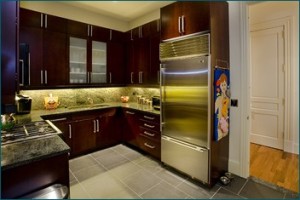
One of Emeril's kitchen's in his Manhattan Condo - Sold for $4.6 million. (Photo Credit: Wall Street Journal)
• Emeril Lagasse Sells Midtown Loft for $4.6 Million
Emeril Lagasse, famous for the catch phrases (“Bam” and “Lets Kick it Up a Notch), and of course for his Cajun cooking, recently sold his loft at the Beekman Regent NYC condo for $4.6 million. Located in Midtown Manhattan, the 4,000-square-foot apartment is a combination of two adjacent apartments that includes two kitchens – both of which have modern and stainless steel appliances, a formal dining room, a media room and two master suites. The apartment also features views of the skyline and the East River whose building’s interior includes 24-karat gold hardware and mahogany wood. According to the New York Post, Emeril won’t have to worry about his living situation that much longer since he reportedly just closed on a 6,900-square-foot Upper East Side townhouse. His new $11.5 million pad is recently renovated and includes two terraces, six fireplaces and a chef’s kitchen.
• Courtney Love to Lease Milla Jovovich’s NYC Townhouse
Much has been reported about adventurous tales of grunge rocker Courtney Love and her search for an apartment in NYC. Seems this tale has a happy ending, at least temporarily, as it was reported that Love is leasing a townhouse from actress/model Milla Jovovich. Love has been living in the luxurious Mercer Hotel in Soho for the past year while searching for a home in the West Village. Love has been looking to live next to Anna Wintour whose board rejected her request. Seems like a perfect situation for both parties as Jovovich has been trying to sell her Greenwich Village townhouse since 2008. Listed for sale at $7.5 million, the four-floor home includes four bedrooms, a private garden, a dining room and a rooftop deck. Curbed NY reported that Jovovich was seeking $24,000/month for rent. However, there was no word if this is what Love will be paying.

Weinberg's home for sale -- listed at $3,399,00. (Photo Credit: The Real Estalker).
• Max Weinberg Asking $3.3 Million for Flipped Home
Max Weinberg, resident drummer on the “Late Night with Conan O’Brien” and former member of Bruce Springsteen’s E Street Band recently listed a Hollywood Hills home for sale. Purchased in February 2009 for $2,888,000, Weinberg and his wife, Rebecca, renovated the home and is now looking to make a profit by listing it for $3,399,000. The contemporary five bedrooms, three bathroom home – previously owned by the parents of Maggie and Jake Gyllenhaal – includes views of the city, a swimming pool among a lush garden and angled stairs and 2,916-square-feet of living space. An infamous house flipper, Weinberg has been purchasing homes in California and New York, renovating them and selling them since the early 2000s.
Which home sparks your interest?

Now, that's what we call an urban garden!
By Kathy Woodard
Urban gardening can seem to be a paradox; how can one garden in a small space especially in places like NYC that are renowned for their cramped apartments? The fact is, it can be done and it is a fast growing trend amongst city dwellers. There are a few guidelines that can help get you started if you too are determined to grow your own piece of paradise, no matter how small your outdoor space.
Grow-in:
The fact is, for most city dwellers you are going to be doing your gardening in containers. The choices in containers are larger now than it’s ever been, including lightweight choices for those of us with balconies and rooftops. Many containers are made to look like expensive pottery or stone, but are in fact easy maintenance foam or other lightweight material. These pots are tough, beautiful and practical, and come in large sizes.
What you put inside the pot is important also. When growing on patios, terraces or balconies, it’s critical to make sure your pots are not too heavy. Using a soil less potting mixture will ensure you have healthy plants without the extra pounds. Many potting mixes even have time release fertilizer right in the mix, eliminating one more aspect of container gardening maintenance.
Grow-up:
When space is limited as it is in an urban garden, think up. Many plants can be grown in pots up trellises, tepees or poles. This is a great way to utilize your small space garden effectively to ensure you have room for a variety of plants. Think easy colorful vines, fresh pole beans, even roses!
Grow-down:
Growing down simply means using hanging pots to create space where there is none! Trailing plants are perfect for this, but shorter upright plants can be used in these designs as well.
What makes your garden grow?
An urban container garden in a small space needs the same things any garden does… water, nutrients and sunlight. Make sure you water regularly, as containers have a tendency to dry out quickly, especially during hot weather. Make sure each container has adequate drainage so the roots don’t sit in water and rot.
Nutrients get washed out of the soil in container plants quickly. Make sure there is a time released fertilizer in your potting soil, and every other watering consider adding a water soluble fertilizer to your watering can at half strength for an added boost.
You may be limited in the plants you can have in your garden if your outdoor space faces only one direction. Whether your small garden space gets mostly shade or mostly sun, or somewhere in between, there are great plants you can use. Be sure to stick to ones for your exposure. Planting a shade loving hosta in the blazing afternoon sun is never going to work. Likewise, expecting dwarf sunflowers to give you beautiful blooms with nothing but filtered shade is unrealistic.
Finally, while there is definitely a lot less weeding and maintenance with a container garden (one of the many percs!) make sure you take care of those things when they occur. Birds can drop weed seeds, flowers still need to be snipped off as they fade and occasionally you will want to replace plants that aren’t working.
Grow this!
Here are my top choices for plants to grow in your urban garden…
Edibles
- Pole and bush beans
- Herbs of all kinds
- Lettuce and other greens
Flowers
- Allysum
- Lobelia
- Geranium
- Sweet potato vine
- Purple fountain grass
- Verbena
Vines
- Pole vegetables
- Morning Glory
- Cardinal Flower
- Black eyed Susan Vine
No matter where you live, there is always a way to garden. Look for what you have, not what you don’t have. Grow, nurture and enjoy a garden in your small space!
Want free home and garden ideas? Kathy Woodard, is an author, columnist and home decorating expert. Visit her at her website www.TheBudgetDecorator.com and also at www.DecoratingYourSmallSpace.com.
August 11th, 2010 by
Admin
Categories:
Celebrity Real Estate,
design and decorate,
Do It Yourself,
exterior projects,
foreclosures,
Home Improvement,
homes for sale,
Insurance,
interior projects,
Mortgages,
Moving,
Plan Your Relocation,
Real Estate,
Relocation,
Relocation Data,
rentals Comments:
1 Comment » 
Joey Fatone's home for sale - To be sold at auction for $6.5 million
By Serena Norr
We had quite the mixed bag of homes for sales and home purchases this week. “Extra” host Mario Lopez recently purchased a 4,430 square-foot home in Glendale, California for the obvious reasons: outdoor pool, courtyard with a fountain and state-of-the art and modern amenities as well as for the not-so-obvious reasons: it will be the location of his new reality show where he and his baby mama will be filmed as they experience the trails of becoming new parents. While some may tune-in to catch Lopez juggle his abdominal workouts while changing diapers, we are more interested in seeing how he will upgrade and personalize his Spanish-style home with home improvement projects and decor. Disney star-turned-actress, Hilary Duff also made this week’s Beat for purchasing an elegant Toluca Lake estate with her fiancé Mike Comrie for $3.85 million. We also reported on an interesting auction of the home of Joey Fatone. Fatone, who was in the band ‘NSync, is asking $6.5 million for the home that features a swimming pool and an outdoor sushi bar. These properties never cease to amuse and amaze us! Until next week…
• Former ‘NSyncer, Joey Fatone Selling Orlando Home for $6.5 Million
Joey Fatone, of the popular 90s boy-band ‘NSync, will auction his home for $6.5 million citing wanting to be closer to his family as the reason for the sale. The gated estate, located in Orlando, is situated on 4.4 acres of lakefront property that includes 10 bathrooms, a 10-car garage and six bedrooms, including a 3,800 square-foot master suite with a butler’s pantry. The home also has 12,400-square-feet of living space that includes a movie theatre with stadium seating and an outdoor grotto area with a sushi bar, swimming pool and spa. The minimum bid for the auction is $3.7 million, which will take place on September 11, 2010.
• Mel Brooks Sells Ocean-Front Home for $5.3 Million
Comedian and director Mel Brooks recently sold his Watermill, New York home for $5.3 million. The 1,968-square-foot property was originally purchased for $2,995,000 by Brooks and his late wife, Anne Bancroft, which has been rented out for several summers. The home, situated by the ocean on. 74 acres, includes three bedrooms, two bathrooms, a fireplace and is right down the street from last week’s celebrity beat seller, Christie Brinkley.
• Leeza Gibbons Buys New Home for $6,600,000
Entertainment reporter Leeza Gibbons recently purchased a home in Beverly Hills, California for $6,600,000. The Mediterranean-style home includes five bedrooms, 5.5 bathrooms and backyard complete with a heated swimming pool, spa and lush greenery. The 6,579-square-foot home also includes walnut wood flooring, a family room, a fitness room, a billiard room, an office, a three-car garage, a home theatre, four fireplaces and a state-of-the-art security system.
• Mario Lopez Gets a New Home for $1,940,000
Mario Lopez of “Saved by the Bell” fame recently purchased a new home in Glendale, California. Sold to Lopez for a modest price tag of $1,940,000 (at least in celebrity real estate terms), the home will soon be seen by the rest of America when VH1 starts filming a new reality series about the trials and tribulations of Lopez’s life with a new baby. If you can’t wait to see the show, we can tell you the Spanish-style home includes four bedrooms, six bathrooms, three-car garage and a gorgeous courtyard with a fountain. The home, built in 1929, is fully renovated that also includes 4,430 square-feet of living space, a eat-in kitchen with modern appliances, an office, a formal dining area with hardwood flooring, arched doorways, fireplace and a swimming pool.

Exterior shot of Hilary Duff's new home - Sold for $3.85 million
• Teen Queen Hilary Duff Buys Home for $3.85 Million
Hilary Duff, former Disney star- and sometimes-designer/singer/actress recently purchased a colonial-style home for $3.85 million with her her fiancé Mike Comrie. Located in Toluca Lake, the elegant 5,260-square-foot two-story house includes five bedrooms, 6.5 bathrooms, an outdoor fireplace and a swimming pool and a modern kitchen with stainless steel appliances. Other amenities include a wet bar, French doors located throughout the home, a curved staircase, high ceilings and hardwood flooring. Duff and her fiancé Mike Comrie can also look forward to getting to know other Toluca Lake residents like Jenny Garth, Gwen Stefani and their next door neighbor, Britney Spears.
August 4th, 2010 by
Admin
Categories:
Celebrity Real Estate,
design and decorate,
Do It Yourself,
exterior projects,
foreclosures,
Home Improvement,
homes for sale,
interior projects,
Moving,
Real Estate,
Relocation,
rentals Comments:
No Comments » By Serena Norr
What an exciting week in the world of celebrity real estate. The home that Michael Jackson rented before he died was listed on the market for a whopping $28,995,000! With seven bedrooms, a game/media room, a theatre and a pool the new owner will never have to leave the property. Meg Ryan also made an appearance on the Beat for leasing her home for rent. Asking price? A mere $40,000 a month — or what we figure is better spent on two years worth of rent. Christie Brinkley is also in the news for placing her beachfront home on the market. She is reportedly a huge fan of home improvement projects but cited lack of time to maintain the property as one of the reasons for the listing. We also reported on the foreclosure of Damon Dash’s (co-founder of Roc-A-Feller Records) NYC condos. Dash reportedly fell into the old spending-more-than-what-you-have bit and was unable to pay his $78,504 monthly mortgage payments.

The estate of the late Michael Jackson - Listed for $28,995,000. (Photo Credit: The Real Estalker)
• Michael Jackson’s Home on the Market for $28,995,000
Yes, those numbers are correct and yes, this is the very home that Michael Jackson rented for $100,000 a month before he passed away in June of 2009 (owner is Hubert Guez, CEO of Ed Hardy). This Holmby Hills estate (located in Los Angeles) is certainly fit for a King, or maybe just the King of Pop. The list of amenities goes on and on for “French Chateau” such as a wood-paneled den, a library, a modern eat-in kitchen, seven bedrooms, 13 bathrooms, seven garage spaces and 12 fireplaces all of which is situated on 1.26 acres of land. On top of all, the 17,171 square feet home (about $1,689 per square foot) also has a wine cellar, a media room, an art studio, a movie theatre, an indoor bar, a spa and a gym, lush gardens and greenery and an heated outdoor pool. Property listings describe this luxurious and gated abode as a “major achievement in design and proportion, incorporating classic design and impeccable craftsmanship and offering the perfect integration of charm and elegance in a world-class setting.” With that asking price and all that is included we wonder what King or Queen will be the reigning owner of this property.

You too can enjoy Meg Ryan's pool -- Listed for rent at $40,000 a month. (Photo Credit: Zillow.com)
• Meg Ryan Renting Her Home for $40,000 a Month
Back in October, actress Meg Ryan listed this California home for $14.2 million only to be removed from the property listings a mere two months later. According to Zillow.com, Ryan has now listed her Spanish-style Bel Air home for rent at $40,000 a month. A bit steep for a lease but the world of celebrity real estate follows its own set of rules. And for whoever can afford this agreement will have quite the gorgeous beachfront estate to look after. The spacious home includes six bedrooms, seven bathrooms, four fireplaces and of course stunning views of the ocean. There is also hardwood flooring, open archways, wood-beamed ceilings and a modern kitchen with state-of-the-art appliances. There are no reports as to how long the rental agreement would last.
• Hip Hop Mogul Damon Dash Losses Home to Foreclosure
Damon Dash, Co-Founder of Roc-A-Feller Records recently lost his TriBeCa condo to a foreclosure. Sold for $5.5 million, Dash reportedly stopped paying his $78,504 in mortgage payments on his two condos — one on Moore Street and the other on Laight Street. (We wonder why one would need two condos in the same neighborhood but perhaps that is a part of the whole celebrity real estate conundrum.) Dash attempted to sell the Moore Street condo right after the real estate market crashed for $7.9 million and again for $5.75 million in 2009 with no interested buyers. Since he was unable to pay his loan, Dash was sued twice and finally ordered to put his home through the auction process by the New York Supreme Court. A California-based finance firm, Platinum Capital, purchased the home. His second home (on Laight Street in NYC) went unsold and was taken over by Eastern Savings Bank.

Steve Carell's new home -- Purchased for $6 million. (Photo Credit: The Real Estalker)
• Steve Carell Buys Home for $6 Million
Steve Carell of “The Office” recently purchased 1.27 acre estate for $6 million dollars. Located in Toluca Lake, California, the 5,126-sqaure-foot home includes six bedrooms, five bathrooms, a pool house and a tennis court. Toluca Lake is home to many celebrity neighbors that Carell can soon mingle with. According to the Real Estalker, Eric McCormack, Markie Post, Swoosie Kurtz, Andy Garcia, Demi Lovato, and Ashley Tisdale all live in Toluca Lake.”

Christine Brinkley's home -- Listed for $15.75 million. (Photo Credit: Luxist.com)
• Christie Brinkley Lists North Haven Home for Sale
Model/socialite and real estate investor Christie Brinkley recently listed her New Haven home on the market for $15.75 million. Built in the 19th century, the waterfront home not only has gorgeous views of the beach and the surrounding bay but is surrounded on 4.5 acres of land and 327 feet of beachfront. The 5,500-square-foot columned mansion has five-bedrooms, six bathrooms, four fireplaces and an outdoor pool. Brinkley cited busyness and an inability to maintain the property as the reason for the sale. She has an avid interest in home improvement projects stating “love fixing up old houses, but my life is so busy between with my children, launching several new businesses and my philanthropy, I just don’t have time.”


July 28th, 2010 by
Admin
Categories:
Celebrity Real Estate,
design and decorate,
Do It Yourself,
exterior projects,
foreclosures,
Home Improvement,
homes for sale,
interior projects,
Moving,
Moving Day,
Real Estate,
Relocation,
rentals Comments:
No Comments » By Serena Norr
At Relocation.com, we are big believers in renovating your home or apartment for obvious reasons (like say, repairing a faulty toilet or fixing broken tiles) or to enhance the look and feel of your house. For homeowners, these projects may increase the value of a home, which can be rather helpful when you are seeking to sell. However, when you spend $50 million (yes, I said $50 million dollars) for a home renovation, we have clearly entered into the mysterious and costly world of celebrity real estate. This exact transaction recently took place in NYC when the designer, Tommy Hilfiger forked over $50 million buckaroos to redesign his duplex. Pictures of the gorgeous home were taken by Harper’s Bazaar so we can all admire the “European-inspired” home from afar and truly see what you can do to your home when money is no object. This week you can also read more about Cameron Diaz who purchased Candice Bergen’s Beverly Hills home for $9.4 million. The homes of the late Jim Morrison and the late Ed McMahon are listed for sale, as well as Sasha Baron Cohen’s home that is listed on the market for $2.9 million. Let us know which home sounds interesting to you. Until next week…
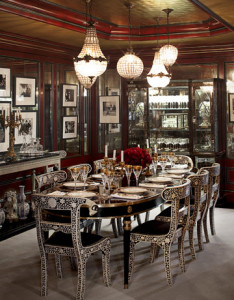
Newly redesigned dining room of Tommy Hilfiger -- The renovations cost the designer $50 million dollars. (Photo Credit: Harper's Bazaar)
• Tommy Hilfiger Renovates Home for $50 Million
Clothing designer Tommy Hilfiger recently renovated his two-floor NYC duplex for the hefty price tag of $50 million. This home improvement project has been in the works for two years to create “an old-world atmosphere complementing the old-world Plaza,” as Hilfiger stated to Harper’s Bazaar. The project involved a complete gut renovation of Hilfiger’s 6,000-square-foot duplex to create a glamorous/vintage European-vibe. And that it certainly is. The newly redesigned duplex now includes a gorgeous Maison Jansen dining room table, crystal chandeliers, a nautical-themed kid’s room complete with a ship bed and a French Renaissance-style turret featuring an Eloise mural by Hilary Knight. There is also a 20-piece collection by Andy Warhol, paintings by Jean Michel Basquiat and an American flag painting by Jasper Johns that Hilfiger is reportedly interested in buying. The home also features a private domed terrace, which overlooks Central Park that was redesigned with checkered flooring, a black sitting table and custom cut plants.
Check out more photos of Tommy Hilfiger’s Plaza home as featured in Harper’s Bazaar.

Jim Morrison's former dining room -- Listed for $1.1 million. (Photo Credit: Zillow.com)
• Jim Morrison’s Laurel Canyon Home for Sale
The Laurel Canyon home of the late Jim Morrison has recently been listed on the market for $1,199,000. Previously sold for $535,000 in 2001, the rustic 2,300-square-foot home is reportedly where Morrison did a lot of his song writing and hung out in the 1960s. The quaint home includes three bedrooms, open beamed ceilings, distressed wood floors, iron fixtures and a outdoor deck with a fire pit, gym and shower, as reported on Housing Watch. The new owner may also discover some of Morrison’s writings behind the wall of an indoor shower where he reportedly kept some of his poetry and songs – Strange Days, indeed.
• Cameron Diaz Buys Candice Bergen’s Beverly Hills Home
According to the Real Estalker, Cameron Diaz recently purchased Candice Bergen’s Beverly Hills home for $9, 447,500. Originally listed for $10,250,000, the 5,000-square foot home features four bedrooms, 4.5 bathrooms and a detached guest house that encompasses almost an acre of land includes another three bedrooms and two bathrooms. The sophisticated home also features hardwood and tiled flooring, high ceilings and an outdoor area with a pool, tennis court, gardens and a spa.
• Sacha Baron Cohen Lists Los Angeles Home for $2.9 Million
Sacha Baron Cohen aka the man behind “Ali G” and “Borat” recently listed his 2,806-square-foot home on the market for $2.9 million. The single-story Los Angeles abode features three bedrooms, 2.5 bathrooms, a detached guest room and a two-car garage. Other amenities in the house include hardwood flooring, a fireplace, French doors leading to the dining room, a modern kitchen with stainless steel appliances and white cabinets and an outdoor deck with a pool and spa.
• Ed McMahon’s Beverly Hills Home on the Market for $4.6 Million
The home of the late Ed McMahon is on the market $4.6 million. Originally listed in 2008 for the same price, the Mediterranean-style is located in a gated community in Beverly Hills that overlooks canyons and a sprawling yard. The California estate includes six bedrooms, 5.5 bathrooms, fireplace and a swimming pool. The seller (who was also a friend of McMahon’s) made significant home improvements on the 7,013-square-foot estate that faced foreclosure in 2008.
July 21st, 2010 by
Admin
Categories:
Celebrity Real Estate,
design and decorate,
Do It Yourself,
exterior projects,
foreclosures,
Home Improvement,
homes for sale,
interior projects,
Mortgages,
Moving,
Moving Day,
Moving Industry,
Packing,
Real Estate,
Relocation,
rentals Comments:
No Comments » ![rushop[1]](http://blog.relocation.com/wp-content/uploads/2010/07/rushop1-300x276.jpg)
The ornate abode of Rush Limbaugh -- Sold for $11.5 million. (Photo Credit: Corocan via the Wall Street Journal)
A few politicos made “the Celebrity Beat” this week. The “Lion of the Senate” aka the late Ted Kennedy’s Washington, DC home was recently placed on the market for $7,995,000. This massive Colonial-style estate includes five bedrooms, six bathrooms, a wine cellar and a personal gym designed by “the Terminator” or Governor Schwarzenegger, as he is referred to these days. On the right side of the political spectrum, Rush Limbaugh’s Upper East Side penthouse was sold for $11.5 million to an undisclosed buyer. Limbaugh has been stating he has wanted out of New York due to the city’s high property taxes — but if you have an $11 million dollar home, we are thinking you have sufficient funds to pay good-old Uncle Sam. To light things up a bit, comedians Cheryl Hines and Adam Carrolla are both selling their California homes. Hines’ home is situated in Brentwood overlooking the mountains; while Carrolla’s home overlooks downtown Los Angeles that was also personally designed and renovated by Carrolla.

Exterior Shot of the Late Ted Kennedy's Home -- Listed at $7,995,000. (Photo Credit: Zillow.com)
• Ted Kennedy’s Home on the Market for $7,995,000
The Washington, DC home of the late Ted Kennedy (Kennedy passed in 2009 after a long bout with brain cancer) is on the market for $7.95 million. Purchased in 1998 for 2.7 million, the 8,900-square-foot home includes five bedrooms, six full-sized bathrooms and two half baths, a wine cellar, an indoor and outdoor pool, a secret hideaway from the library and an indoor gym designed by no other than the movie star-turned-gobernador Arnold Schwarzenegger! Described as a “Colonial-style home” whose decor features long white columns, French doors, high ceilings, an outdoor terrace, gardens and a massive dining room that is customized to fit 50 people. Listed by Vicki Kennedy (Kennedys’ widow), who is seeking a smaller home in Washington, DC. According to the Wall Street Journal, the home is “quietly being shopped around” with no current buyer.

Exterior View of Cheryl Hines Brentwood Home -- Listed at $4,249,000. (Photo Credit: Paul Barnaby via the Wall Street Journal)
• Cheryl Hines Lists Brentwood Home for $4,249,000
Comedian and “Curb Your Enthusiasm” star Cheryl Hines recently listed her walled and gated Mandeville Canyon-area estate for $4,249,000.The 4,908-square-foot home sits on an acre of land that features stunning views of the nearby California mountains and new furnishings and renovations throughout the properties open-floor plan. If that isn’t enough, perhaps the homes six bedrooms, 5.5 bathrooms, a guest house and an outdoor pool with massive trees throughout the property may entice you to buy?
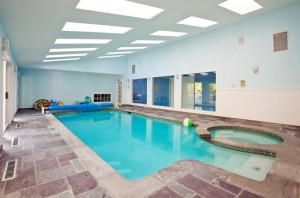
Joe Torre's home includes an indoor swimming pool -- Listed at$1,175,000. (Photo Credit: Zillow.com)
• Joe Torre’s Home Listed for Auction at $1,175,000
Joe Torre, former coach of the New York Yankees and current coach of the Los Angeles Dodgers has recently placed is New Rochelle, New York to be sold via a public auction. Located 30 minutes from Manhattan, the 6,500-square-foot home is listed at $1,175,000 that is expected to exceed the asking price. Some notable features about the two-level property includes six bedrooms, five bathrooms, an indoor pool and a three-car garage all of which is situated on 1.01 acres of land. The first level features a family room, a fireplace, and a large kitchen; while the second level has a master suite, guest rooms and a laundry room. Owners of the property will also become stockholders of the estate property company. For more information on the auction, visit BidOnTheCity.com.

Rush Limbaugh's master bedroom complete with a ceiling mural -- Sold for $11.5 million. (Photo Credit: Corocan via the Wall Street Journal)
• Rush Limbaugh Finds Buyer for NYC Penthouse
On another side of the political spectrum, conservative pundit Rush Limbaugh has found a buyer for his Upper East Side NYC penthouse. Originally listed for $13.95 million, the undisclosed buyer will pay $11.5 million for the condo, according to the Wall St. Journal. The full-floor penthouse overlooks Central Park and features 10 rooms, four terraces, a 30-foot-wide living room and a private elevator. The new buyer will also enjoy personal decorating touches of the conservative talk-show host such as ornate wall designs and a mural of clouds and birds in the master bedroom, along with various ceiling murals throughout the penthouse featuring palm trees and the beach. Limbaugh is relocating from New York due to the high property taxes, which he announced in February on his radio-show entitled “El Rushbo to New York: Drop Dead.”

Adam's Carolla's Home for Sale-- Listed at $1,395,000. (Photo Credit: the Luxist)
• Adam Carolla Lists Home for $1.3 Million
Comedian, Adam Carolla recently put his Beachwood Canyon home on the market. Carolla – who also owns two other properties in the Los Angeles-area – personally did all of the renovations on this three-bedroom as stated on the Luxist, “the home was totally rebuilt, piece by piece, like a restoration of an old car with modern equipment.” With a contractor background, Carolla spent at least $350,000 in home improvements on his 2,281-square-feet French-style home. The “ultimate bachelor pad,” that was “overbuilt,” as stated by Carolla, includes some interesting features such as an office, an indoor and outdoor bar, an updated kitchen with state-of-the-art appliances and a soundproof basement. The exterior of the house is also pretty impressive, which resembles a castle and overlooks downtown Los Angeles and views of the Hollywood sign.
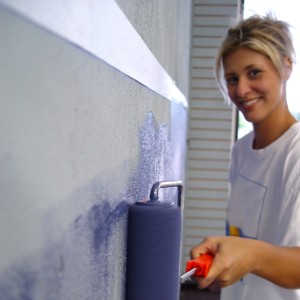
A new coat of paint can really spruce up your home.
By Kathy Woodard
Now that moving is over and you’re finally in your new home, it’s time to make it your own and add some of your style and personality. There are some simple home improvement fixes to change your new home that anyone can do. With one weekend and a little elbow grease, you can have your place in tip top shape in no time!
Paint:
Ok, I know this is an obvious one. The reason you hear painting as the number one DIY project for new homeowners so often is because it’s effective. And cheap. And easy. What more could you want? Make sure you plan out your color scheme for each room or the whole house before you ever visit a paint store. Many a new homeowner has ended up with what in the store appeared to be a bold, trendy color, only to discover that their new home was pink — really pink. Consider not just walls, but kitchen and bathroom cabinets, trim and doors as well. Plan, prepare and try out sample paints before you take a whole project on, but do paint!
Paint more…
Yea, I know, back to the paint thing. But did you know you can paint more than walls? By using a good primer and some polyurethane for protection, just about anything can be painted. Some ideas?
• Ugly bathroom countertops? If you can’t afford replacement counters, no worries. Prime, paint with a faux stone finish, then seal with polyurethane. Instant style update, without the remodeling price!
• Does your new kitchen come complete with avocado green appliances? You can spray paint them with auto spray paint to camouflage the 1970s look. If you paint a stove, make sure you use stove paint to protect the finish from the heat. Most home improvement stores carry a good brand.
• Yucky pink tile in the bathroom? Again, prime with a good primer, then paint. There are specialty paints for just this purpose, or you can use regular house paint and seal well with polyurethane.
• Even vinyl flooring can be painted. Keep in mind however, the higher the amount of traffic the floor receives, the more coats of polyurethane you will want to use for protection.
Add curb appeal:
You can increase the curb appeal of your new home in a day with some simple fixes. Replace your house numbers with something more in line with your personal style. Add a new mailbox, and update the light fixtures on your porch. Consider adding a window box or two. Use ornamental grasses in your box to give your home a contemporary feel different from the other houses on the block. Finally, paint the front door. Making these easy changes will brand your house as yours from all the way down the street!
Add storage:
Most homes never have enough storage, so think about making that one of your first home improvement projects. Closet and pantry systems are available at most home improvement centers and are easily installed by a beginning DIYer. Don’t forget the garage! Even adding simple shelves, hooks and hangars for tools and other items can double your storage space.
Quick changes:
There are also some simple projects you can do in less than an hour. Change out the cabinet hardware in the kitchen and bath. Choose new glass shades for all your ceiling mount light fixtures. Replace mismatched window treatments with inexpensive blinds. Add curtain sheers. Clean your windows inside and out to add sparkle to every room!
There you have it, simple fixes to change your new home, without needing a class in engineering or the bank account of a celebrity!
Want free home and garden ideas? Kathy Woodard is an author, columnist and home decorating expert. Visit her websites: TheBudgetDecorator.com and DecoratingYourSmallSpace.com.
More articles for your home improvement plans:
June 21st, 2010 by
Admin
Categories:
design and decorate,
Do It Yourself,
exterior projects,
Home Improvement,
interior projects,
Moving,
Moving Day,
Moving Industry,
Plan Your Move,
Real Estate,
Relocation,
Saving Money Comments:
No Comments » 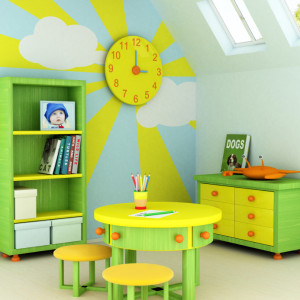
Shedding Some Light on a New Room
By Kathy Woodard
Congratulations, you have survived the moving process to your new home! Although your kids accepted the moving news, they may be feeling less than settled in — as well as a little scared and uneasy once they are in their new home. One of the best ways to help kids make the transition after a move is create a space that is all their own by decorating their room. This will help them create a new look for their new room, as well as offer a creative outlet and a way for them to express themselves.
Start talking about decorating your child’s new room before moving day. Allow the excitement to help with those difficult transitions. Brainstorm ideas with your child, so you can get an idea of what appeals to them!
As soon as you are settled into your new home, start making decorating your kids rooms a reality. Take them shopping in your new community to get ideas for their room décor. (This is a also a great way for them to start feeling more at home)
Create a plan with your child, not for them. You want to make sure your child is involved in the whole process. This way they will feel a real kinship with their new space, and taking ownership goes a long way toward getting over that homesick feeling for all they left behind at their old home.
Pick a theme and a color scheme with your child. This doesn’t have to be some cutesy cartoon character theme or anything commercial at all. Perhaps your 10-year-old wants a chic, stylish room painted in pinks and greens; while your toddler may want fish and mermaids. As soon as you identify your theme, write it down and have them make a drawing or list of what things they would like included in their room. Make sure they include the necessities like window coverings and storage, in addition to the beaded curtain they want as a closet door, or the disco ball they will insist will make a great bedroom lamp. Sit down together, and make choices as to what will be acceptable to you, and what you can afford.
Come up with creative ways you can make the room happen within your budget, and work on these home improvement projects together. Some money saving ideas?
• Sew two sheets together on three sides and insert their old comforter for an inexpensive duvet cover.
• Use paint to create the feeling in the room. Whether your child is quiet and shy, outgoing and vivacious, or somewhere in between, the right color scheme for their personality will make the difference between the room being a success, or a dud! Paint is cheap; use it ravishingly to create a fantasy for your child.
• Visit dollar shops for accessories for your child. Fun picture frames, storage baskets in bright colors, and themed toys to use for décor are all easy finds that will save you big money. Remember, stick to your theme!
• Craft and fabric stores are a gold mine for the DIY decorator. Use iron on hem tape to create simple curtains and throw pillows. Use craft foam in your rooms colors to cut out shapes that can be used as 3-D art on the walls.
• Visit thrift stores and yard sales to find rugs, lamps and accessories that can be renewed with a quick update of paint or fabric.
Finally, make a party of decorating day. Assemble all the ingredients and implement them all at once, instead of gradually. This gives a dramatic effect and underlines the importance this new space has for the child. Allow them to invite a couple of their new friends over to celebrate, or make it a family affair with a barbecue or the child’s favorite dinner.
Decorating for kids when you move to a new home can be a fun and a healthy transitional experience for both parent and child. Take advantage of the situation to make it a bonding experience you will both remember.
Want free home and garden ideas? Kathy Woodard is an author, columnist and home decorating expert. Read more articles written by Kathy on the websites TheBudgetDecorator.com and DecoratingYourSmallSpace.com.
June 14th, 2010 by
Admin
Categories:
design and decorate,
Do It Yourself,
exterior projects,
Home Improvement,
Moving,
Moving Scams,
Packing,
Plan Your Move,
Plan Your Relocation,
Relocation,
Relocation Data,
Saving Money Comments:
No Comments »

Start small and your garden will grow
By Kathy Woodard
Whether you are moving to a new home or have lived in your residence for a long time, there are certain home improvement projects that can spruce up your landscape and add value to your property, while also being an enjoyable activity for you and your family. As the top hobby in the country and a fun home improvement project, gardening beautifies your property, relieves stress, offers good exercise and even supplies you with fresh herbs for your dinner. Not to mention, it allows you the opportunity to commune with nature in your own backyard! Not knowing how to garden can stop many people from picking up that first trowel or planting that gorgeous rose they have long admired. No need to fear those hydrangeas, beginners can easily learn how to garden by following these simple tips.
Learn, learn, learn.
There are so many resources now for learning about gardening. Libraries and book stores overflow with gardening books and the internet has a wealth of information. Consider joining a local gardening club or online forum. Start a notebook where you can keep magazine pages of yards or plants you’ve admired, notes from online searches, or snapshots of your yard, both before you start gardening and as you progress.
Don’t bite off more than you can chew.
The biggest mistake beginner gardeners make is to start with too large a garden, or to use plants that require an expert’s care. You can always add more to your garden as you gain experience; nothing is as off putting to a newbie as a huge garden that turns, practically overnight, from gorgeous blooms to overrun weeds. Talk about taking the bloom off the rose! It’s common to quit gardening after a bad experience, so don’t let this mistake choose for you. Start small. Start simple.
Plan… but be flexible.
Make sure you spend some time drawing out a plan for your new garden. Make lists of plants that you would like to try, and research what times of year they bloom or fruit and what their special needs are. Group plants with similar needs together. Make sure shade plants are planted in shade, and sun plants in the sun. All that have been said don’t be afraid to try something new. Sometimes a volunteer plant will pop up and look just gorgeous right where it is. Other times you will have chosen a certain plant for a site and find that even after all your preparation, it doesn’t do well there. So, move it! Head to the nursery with a list, but don’t be afraid to substitute a plant for a new find. (Be careful with this one, you may come home with twice the plants you need!) Also, make sure that you purchase the proper gardening tools and don’t be afraid to ask for help!
Find a passion within your garden.
Once you learn a bit about how to garden, most beginners find a niche in gardening that ignites their passion. Find it, and enjoy it. Wildlife gardening, growing your own food, growing flowers for your own arrangements or water gardens complete with koi and living water plants are common passions. Letting yourself find that connection with the outdoors that speaks to you will only enhance your love of gardening all the more.
Consider hiring help.
If you love the idea of having a garden, or have gotten in a little over your head, hiring a gardener can be the perfect solution.
• Decide what kind of help you need. Do you need just regular mowing and fertilizing, while you take care of the flower beds? Do you want your gardener to do it all? Are you somewhere in between? Knowing what you need and what you can afford is the first step.
• Ask for reference from family and friends.
• Choose a garden service you can communicate with well. The last thing you want is for your new “help” to cut down the prize hydrangea you have been growing all season, or to use pesticides on your organic vegetables.
Learning how to garden is a fun and healthy hobby for beginners. Just follow these tips to get turn all your fingers into “green thumbs”!
Want free home and garden ideas? Kathy Woodard is an author, columnist and home decorating expert. To read more articles by Kathy, visit The Budget Decorator and The Garden Glove.